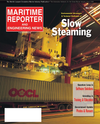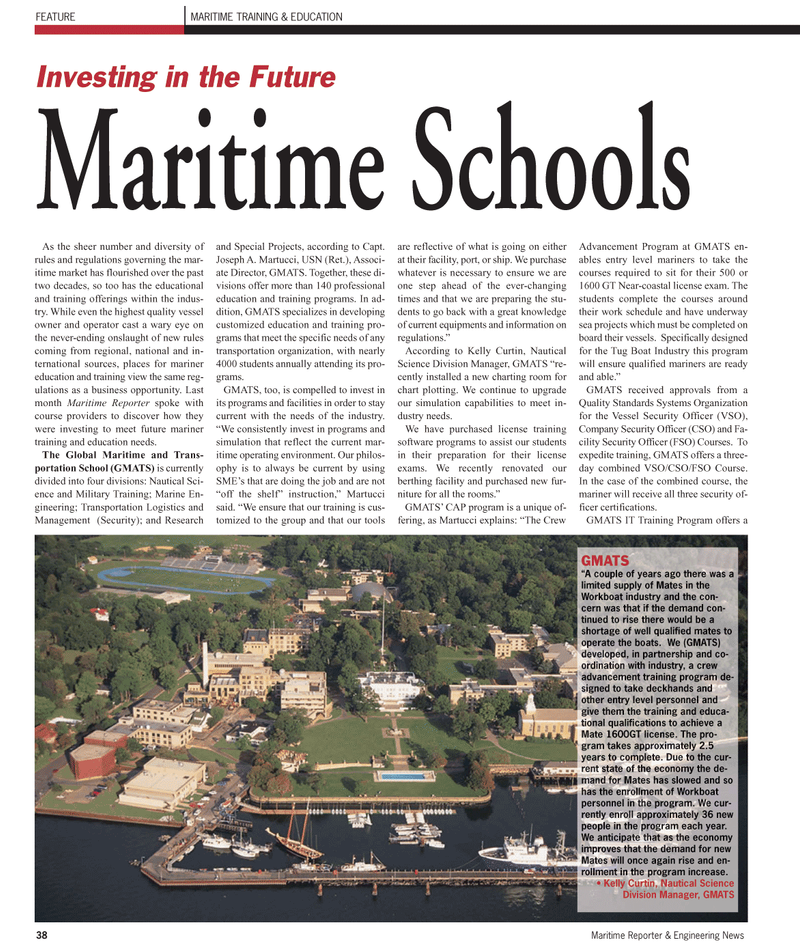
Page 38: of Maritime Reporter Magazine (May 2, 2010)
Read this page in Pdf, Flash or Html5 edition of May 2, 2010 Maritime Reporter Magazine
38 Maritime Reporter & Engineering News
FEATURE MARITIME TRAINING & EDUCATION
As the sheer number and diversity of rules and regulations governing the mar- itime market has flourished over the past two decades, so too has the educational and training offerings within the indus- try. While even the highest quality vessel owner and operator cast a wary eye on the never-ending onslaught of new rules coming from regional, national and in- ternational sources, places for mariner education and training view the same reg- ulations as a business opportunity. Last month Maritime Reporter spoke with course providers to discover how they were investing to meet future mariner training and education needs.
The Global Maritime and Trans- portation School (GMATS) is currently divided into four divisions: Nautical Sci- ence and Military Training; Marine En- gineering; Transportation Logistics and
Management (Security); and Research and Special Projects, according to Capt.
Joseph A. Martucci, USN (Ret.), Associ- ate Director, GMATS. Together, these di- visions offer more than 140 professional education and training programs. In ad- dition, GMATS specializes in developing customized education and training pro- grams that meet the specific needs of any transportation organization, with nearly 4000 students annually attending its pro- grams.
GMATS, too, is compelled to invest in its programs and facilities in order to stay current with the needs of the industry. “We consistently invest in programs and simulation that reflect the current mar- itime operating environment. Our philos- ophy is to always be current by using
SME’s that are doing the job and are not “off the shelf” instruction,” Martucci said. “We ensure that our training is cus- tomized to the group and that our tools are reflective of what is going on either at their facility, port, or ship. We purchase whatever is necessary to ensure we are one step ahead of the ever-changing times and that we are preparing the stu- dents to go back with a great knowledge of current equipments and information on regulations.”
According to Kelly Curtin, Nautical
Science Division Manager, GMATS “re- cently installed a new charting room for chart plotting. We continue to upgrade our simulation capabilities to meet in- dustry needs.
We have purchased license training software programs to assist our students in their preparation for their license exams. We recently renovated our berthing facility and purchased new fur- niture for all the rooms.”
GMATS’ CAP program is a unique of- fering, as Martucci explains: “The Crew
Advancement Program at GMATS en- ables entry level mariners to take the courses required to sit for their 500 or 1600 GT Near-coastal license exam. The students complete the courses around their work schedule and have underway sea projects which must be completed on board their vessels. Specifically designed for the Tug Boat Industry this program will ensure qualified mariners are ready and able.”
GMATS received approvals from a
Quality Standards Systems Organization for the Vessel Security Officer (VSO),
Company Security Officer (CSO) and Fa- cility Security Officer (FSO) Courses. To expedite training, GMATS offers a three- day combined VSO/CSO/FSO Course.
In the case of the combined course, the mariner will receive all three security of- ficer certifications.
GMATS IT Training Program offers a
Investing in the Future
Maritime Schools
GMATS “A couple of years ago there was a limited supply of Mates in the
Workboat industry and the con- cern was that if the demand con- tinued to rise there would be a shortage of well qualified mates to operate the boats. We (GMATS) developed, in partnership and co- ordination with industry, a crew advancement training program de- signed to take deckhands and other entry level personnel and give them the training and educa- tional qualifications to achieve a
Mate 1600GT license. The pro- gram takes approximately 2.5 years to complete. Due to the cur- rent state of the economy the de- mand for Mates has slowed and so has the enrollment of Workboat personnel in the program. We cur- rently enroll approximately 36 new people in the program each year.
We anticipate that as the economy improves that the demand for new
Mates will once again rise and en- rollment in the program increase. • Kelly Curtin, Nautical Science
Division Manager, GMATS

 37
37

 39
39
